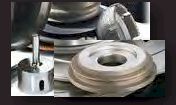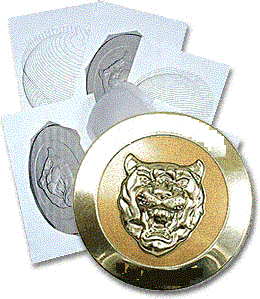|
Services |
|
|
Texturing begins with any type of mold. Working from a variety of patterns,
and designs, a mold surface is engraved. The result is a final product with a
richer, dimensional quality. Any size product can be textured. From the interior
panel of automobiles, to the smallest of recreational and household products,
texturing has proved to be the best way of reproducing a great number of
designs.
|
|
|
Mold Finish |
|
|
Mold surfaces to be textured should have a 240 emery finish free of scratches or
rough grinding marks. For proper etching results, all the oxide scale layer from
Electrical Discharge Machining must be removed from the surface that is to be
textured. It is also necessary to strip chrome-plated molds before texturing. |
|
|
|
|
|
Polished Surfaces |
|
|
Molds that require a polished surface should, whenever possible, be polished
after texturing. If a mold requires heat treating we recommend that this process
be done after the mold has been textured. |
 |
|
|
|
|
Draft |
|
|
Minimal draft on sidewalls could present a problem. The solution is to keep
graining shallow. Areas more critical than others should be kept even shallower.
It is improtant to allow 1 degree - 1 1/2 degree draft for every .001 depth of
etch. |
|
|
|
|
|
Welds |
|
|
When it is necessary that a mold be welded, the mold should be pre-heated to 900
degrees F, and the filler material being used should be the same as the mold
material. Special care must be taken not to bench the weld beneath the original
etching. However, any variations resulting from the welding process can be
corrected. |
 |
|
|
|
|
Glass Bead Blasting |
|
|
Any variety of gloss level can be applied to your plastic part by using
different Bead Blast Grits on your mold surface. When a specific gloss must be
maintained, it is important to send us the spec. numbers or a sample part with
the required gloss on it. |
|
|
|
|
|
Photo Processing |
|
|
Photo-process enables us to duplicate a wide variety of texturing patterns. You
may select from our own collection of patterns, or we can create any new
patterns that you have fashioned. |
 |
|
|
|
|
Engraving |
|
|
Lettering, numbers, logos, emblems, and special designs will give your product
its distinctive idnetifying character. Also, by texturing multiple molds we can
help you develop a complete matching line of products. |
|
|
|
|
|
Texturing Saves |
|
|
The cost of manufacturing a completely new tool far exceeds the cost of having
the old tool textured. Thus, for a small investment, a manufacturer can achieve
a new look for his product while increasing its sales appeal. |

|
|
|
|
|
Engraving Molds for Plastics |
|
Engraving molds for plastics is especially beneficial. Sinks and production
flaws show up easily on plain, untextured plastic, and smooth polished plastic
scratches easily. Flaws and scratches disappear in a textured surface. This
means LOWER PRODUCTION COSTS for you, as you
(1) Reduce rejections(2) Minimize scrap loss
(3)Eliminate costly mold finishing. |
|
|
|
|
|
Materials |
|
|
Base materials that are adaptable to etching fall into ferrous and non-ferrous
categories. The metals most widely used are P-20 Steel, Kirksite, Aluminum,
Brass, Copper, Zinc, Beryllium, and Nickle. |
 |
